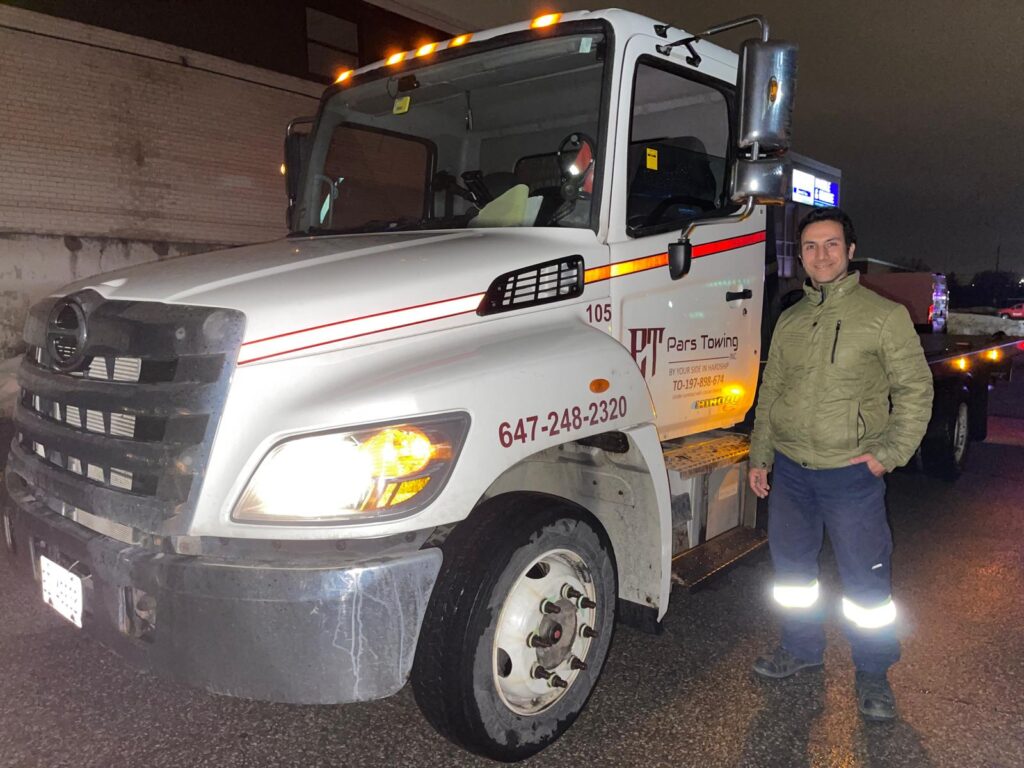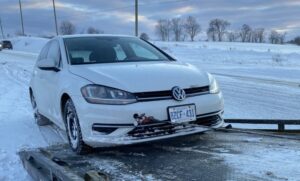As a trusted towing service in the Aurora and greater Ontario area, Pars Towing sees firsthand the devastating aftermath of collisions. Unfortunately, one of the most insidious, yet preventable, causes of these accidents is Drowsy Driving. This impairment is as dangerous as driving under the influence of alcohol, yet it often goes unrecognized and untreated by drivers until it’s too late. Our commitment is not just to clear the road after an incident, but to help keep our community safe by raising awareness about the profound dangers of fatigue and providing actionable steps to prevent it.
The purpose of this comprehensive guide is to shine a light on the reality of Drowsy Driving in Ontario, detail how fatigue impairs your ability to drive safely, outline the serious risks—both personal and legal—and provide proven strategies that all drivers, especially those commuting long distances on highways like the 400-series near Aurora, can use to stay alert and avoid becoming another statistic.
- Learn More >>>>>Best Safety Tips For Driving In The Rain And Snow
The Hidden Epidemic: Drowsy Driving in Ontario
The scale of Drowsy Driving on Ontario roadways is alarming. It’s not just an occasional inconvenience; it’s a significant contributing factor to fatal and injury-causing crashes.
The Facts and Statistics
Research from the Traffic Injury Research Foundation (TIRF) and the Ontario Ministry of Transportation paints a stark picture:
- Significant Crash Factor: Estimates suggest that around 26% of all fatal and injury crashes in Ontario are related to fatigued driving. This means that more than one in four serious accidents on our roads can be tied back to a driver being too tired.
- The Number of Affected Drivers: Nearly 60% of Ontario drivers—a number corresponding to approximately five million people—admit to having driven while feeling fatigued or drowsy at least occasionally.
- Falling Asleep at the Wheel: In a single year, over a million Ontario drivers (14.5%) admit they have actually fallen asleep or nodded off, even if only for a moment, while driving. Collectively, this represents over 5.5 million trips during which a driver briefly lost consciousness at the wheel.
These figures illustrate that Drowsy Driving is a common, everyday risk, one that many drivers do not take as seriously as they should. In fact, many police officers surveyed stated they had stopped a driver suspected of impairment only to discover the cause was fatigue, suggesting the public often under-recognizes the severity of the problem compared to law enforcement.
Who is Most at Risk?
While anyone can experience fatigue, certain groups face a significantly higher risk of Drowsy Driving crashes:
- Commercial Drivers: Long-haul truckers, tow truck operators, and other professional drivers, including those working for Pars Towing, are constantly exposed to long, monotonous driving hours, often during natural sleep times. The law imposes strict Electronic Logging Device (ELD) requirements to track hours, but vigilance is always necessary.
- Shift Workers: Those who work night or rotating shifts disrupt their body’s natural circadian rhythm, making them highly susceptible to fatigue during their commute.
- Drivers with Sleep Disorders: Individuals with undiagnosed or untreated conditions like sleep apnea or chronic fatigue are at an elevated risk.
- Young Drivers: Drivers under the age of 25 are frequently cited in statistics for fatigue-related collisions.
- Medication Users: Drivers taking certain medications that list drowsiness as a side effect must be extremely cautious.

- Learn More >>>>>Can Towing Ruin the Transmission?
The Dangerous Effects of Sleep Deprivation on Driving
To truly grasp the danger, it is critical to understand the physiological and cognitive impact of sleep deprivation. Drowsy Driving doesn’t just mean a few yawns; it means a fundamental degradation of your driving skills, making you just as impaired as a drunk driver.
The “Drunk Driving Equivalent”
Scientific research has established a clear parallel between sleep deprivation and alcohol impairment:
- 17-19 Hours Awake: Driving after being awake for 17 to 19 hours straight is comparable to driving with a Blood Alcohol Concentration (BAC) of 0.05%.
- 24 Hours Awake: Being awake for a full 24 hours results in an impairment level equivalent to a BAC of 0.10%—which is above Canada’s legal limit for intoxication (0.08%).
This means that a driver pulling an all-nighter or severely restricting their sleep is driving in a state of impairment that many would associate only with illegal alcohol consumption.
Impairment of Key Driving Skills
When you are fighting Drowsy Driving, your brain’s function is compromised in several critical areas:
- Slower Reaction Time: This is one of the most immediate effects. The time it takes you to register a hazard (like a brake light, a pedestrian, or an animal) and physically react (by hitting the brake or steering) can double or more. In a fast-moving highway environment near Aurora, this delay can be the difference between a near-miss and a catastrophic crash.
- Impaired Judgement and Decision-Making: Fatigue targets the prefrontal cortex—the part of the brain responsible for logical reasoning and complex thought. Tired drivers become impulsive, less rational, and are prone to making poor decisions, such as speeding up to beat a yellow light or attempting risky maneuvers.
- Reduced Concentration and Focus: Drowsy Driving causes you to lose focus, wander in thought, and experience tunnel vision, where your peripheral awareness fades. You may miss critical road signs, traffic signals, or the vehicle next to you.
- Micro-Sleeps: Perhaps the most terrifying danger, a micro-sleep is an involuntary, momentary lapse into unconsciousness lasting from a fraction of a second up to 30 seconds. The driver is completely unaware it has happened, but even a two-second micro-sleep at 100 km/h means you have travelled over 55 metres (more than half a football field) completely out of control.
- Learn More >>>>>Aurora Towing: Our Average Wait Time Promise
Recognizing the Warning Signs of Drowsy Driving
Self-awareness is the first and most crucial line of defense against Drowsy Driving. The brain is poor at assessing its own level of impairment, but the body sends clear signals. Never try to “power through” these warnings; they are your body’s emergency alarm.
Immediate Physical and Cognitive Symptoms
If you experience any of the following signs, you must pull over immediately:
- Yawning or Blinking Frequently: Persistent yawning is a clear physiological demand for more oxygen and sleep. Frequent blinking or heavy eyelids indicate your eyes are struggling to stay open and focused.
- Difficulty Maintaining Lane Position: You notice your vehicle drifting toward the shoulder (hitting the rumble strips) or crossing over the center line. This is a tell-tale sign of loss of motor control.
- Wandering or Disconnected Thoughts: You find yourself “daydreaming,” having trouble focusing on the task of driving, or feeling confused.
- Trouble Remembering the Last Few Kilometers: You suddenly realize you can’t recall passing a landmark or a specific stretch of road—this is a sign of brief micro-sleeps or severe loss of focus.
- Missing Exits or Traffic Signs: Your visual scanning and processing capabilities are deteriorating, causing you to overlook critical information.
- Restlessness and Irritability: You feel cranky, aggressive, or unable to get comfortable in your seat.
- Inconsistent Speed: Your speed keeps creeping up or dropping down without conscious effort.
How To Avoid It: Effective Prevention and Mitigation Strategies
The only true cure for Drowsy Driving is sleep. All other measures are temporary fixes. Safe driving in Ontario, particularly on long stretches of highway near cities like Aurora, requires proper planning and self-discipline.
Proactive Prevention: Before You Start Driving
The most effective ways to combat fatigue happen before you even turn the ignition key:
- Get Adequate Sleep: The National Sleep Foundation recommends 7 to 9 hours of sleep for adults before any long trip or day of demanding driving. Ensure you are well-rested.
- Avoid Peak Sleepiness Times: Your body has two natural low points based on your circadian rhythm: 2 a.m. to 6 a.m. and 1 p.m. to 3 p.m. Avoid driving during these windows if at all possible, as the drive to sleep is almost irresistible.
- Eat Lightly and Healthily: Heavy, fatty, or sugary meals can induce post-meal drowsiness (the “food coma”). Opt for lighter, more nutritious snacks and stay well-hydrated with water. Dehydration contributes to fatigue.
- Review Medications: Check the warning labels on all medications—prescription and over-the-counter—for “may cause drowsiness” warnings. If unsure, consult your doctor or pharmacist.
- Use the Buddy System: Whenever possible, drive with a passenger who can monitor your alertness, provide conversation, and take over driving duties when necessary.
- Learn More >>>>>Towing Service Near Me: Your Essential Guide
In-Transit Mitigation: When You Feel Tired
If you are already driving and the symptoms of Drowsy Driving begin to appear, the solution is immediate and non-negotiable: Pull Over and Nap.
- Stop Immediately and Safely: As soon as you recognize the warning signs, find a safe, secure, and well-lit place to park, such as an official rest stop, service plaza, or truck stop.
- Take a Power Nap: The recommended strategy is the “Caffeine Nap.”
- Sip: Drink a cup of coffee or a caffeinated beverage (approximately 150 mg of caffeine).
- Sleep: Set an alarm for 20 minutes and take a nap. A nap longer than 20-30 minutes risks entering deep sleep, which can lead to grogginess upon waking.
- Wait: It takes about 15-20 minutes for the caffeine to kick in. The nap provides immediate rest, and the caffeine provides a temporary boost after you wake up, allowing you to safely drive for another hour or two to your next planned stop.
- Take Regular Breaks: On any long-distance trip, stop at least once every 100 miles or two hours. Get out of the vehicle, walk around, stretch your limbs, and get some fresh air to boost oxygen circulation.
Ineffective “Tricks” to Avoid
Many drivers try quick fixes that simply mask the problem without addressing the underlying fatigue. These tactics are dangerous because they create a false sense of security:
- Blasting the Air Conditioning or Opening Windows: The shock of cold air is momentary. It will wear off quickly, leaving you just as tired.
- Turning Up the Radio: Loud music may provide a brief jolt of sensory input, but it’s not a substitute for sleep and can become an added distraction.
- Eating Sugary Snacks: The sugar rush is followed by an energy crash, making your fatigue worse.
- Relying on Energy Drinks: These drinks are heavy on caffeine and sugar, providing only a short, unsustainable lift before a severe crash.
If you are too tired to drive safely, no amount of coffee or loud music will fix the problem—you need sleep.

- Learn More >>>>>5 Good Driving Habits That Save You Money
The Legal and Financial Consequences in Ontario
While there is no specific charge in Canada solely for “Drowsy Driving,” the consequences of fatigue-related accidents are severe and are dealt with under existing criminal and provincial laws.
Civil Liability and Negligence
Every driver in Ontario has a legal duty to exercise reasonable care while operating a motor vehicle. If a driver fails to pull over when experiencing symptoms of fatigue and causes an accident, they can be found negligent in a civil claim for injuries.
- Negligence: Choosing to drive after little to no sleep, or ignoring the clear signs of sleepiness (like drifting or nodding off), can be used as evidence of a driver’s failure to take reasonable care, opening them up to significant financial liability for injuries and damages.
Criminal and Provincial Charges
If a fatigue-related incident results in reckless behaviour or serious harm, the driver can face criminal charges under the Criminal Code of Canada or charges under Ontario’s Highway Traffic Act (HTA):
- Dangerous Driving or Criminal Negligence: In extreme cases where an accident leads to death or serious injury, prosecutors can pursue criminal charges like dangerous driving or criminal negligence. A tired driver who causes a fatal crash is often treated no differently than an impaired driver in the eyes of the law.
- HTA Violations: The most common immediate consequence of Drowsy Driving is a charge for the moving violation it causes, such as unsafe lane change, failure to drive in a marked lane, or speeding. These charges carry fines, demerit points, and potential license suspension, especially for novice drivers.
In short, while the word “Drowsy Driving” might not be on a police ticket, the results of the condition—an accident, a swerve, or a violation—can lead to profound legal penalties, criminal records, skyrocketing insurance rates, and devastating personal loss.
- Learn More >>>>>How to winterize your vehicle
Pars Towing: Supporting Road Safety in Aurora and Beyond
At Pars Towing, we are dedicated to the safety of the Aurora and Ontario community. Our business exists to help people recover from the unfortunate reality of roadside incidents. While we are always ready to provide fast, professional towing and roadside assistance across the Greater Toronto Area, our greater hope is that you never need to call us for a fatigue-related crash.
Our team, including our own commercial drivers, is rigorously trained on fatigue management because we understand that road safety starts with a well-rested driver. We urge all drivers to adopt the prevention strategies outlined in this article.
If you are ever on the road near Aurora, Vaughan, Richmond Hill, or the surrounding Ontario highways, and find yourself experiencing symptoms of Drowsy Driving:
DO NOT try to make it to your destination.
PULL OVER to the nearest safe location immediately.
If you are involved in an accident due to fatigue, or any other cause, and require emergency towing services in the Aurora area, contact Pars Towing right away. We are here 24/7 to ensure a swift and safe recovery of your vehicle.
Drive safely, plan your rest, and remember that preventing Drowsy Driving is a shared responsibility that saves lives and keeps our Ontario roads secure for everyone.
- Learn More >>>>>The Absolute Best Tow Truck Near Me
Conclusion: Make the Safe Choice
Drowsy Driving is a silent killer on Canadian roads, responsible for a staggering percentage of serious collisions in Ontario. The research is unequivocal: driving fatigued is driving impaired. The decline in your reaction time, judgement, and focus can lead to catastrophic consequences that are permanent.
Drivers in Aurora and across Ontario must move beyond the ineffective quick fixes and embrace the only proven solution: adequate rest and immediate stopping when fatigue sets in. By prioritizing sleep, planning breaks, and recognizing the critical warning signs, we can collectively and dramatically reduce the toll that Drowsy Driving takes on our community. Choose to drive safe; choose to drive alert. The life you save could be your own, or that of someone you share the road with.







